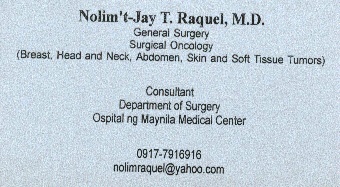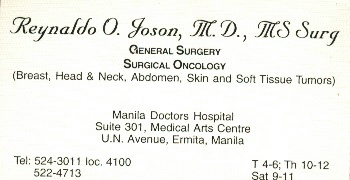By Nilo Y. Rivera, MD
Medical Observer, December, 2002
Having a dermatology practice in a fifth class municipality is no easy work. One must contend with more morbid cases of pathologic dermatology and few of cosmetic dermatology. To the rural folks, skin problems usually take a back seat in their budgetary priorities. They don’t seek consultation unless the symptoms are unbearable or the lesions widespread. These patients first go to the general practitioners, believing that it is expensive to go to a dermatologist.
We cannot blame them. Some of our colleagues charge exorbitant fees that the poor patients after seeing them have no money left except for their transportation fare. Because of this, their other option is to consult the traditional health practitioner or herbolario.
The so-called traditional practices of treating skin diseases may seem funny to some or may even be shocking to the uninitiated. You may have heard about them or have had first hand experience. The examples that I will mention are purely anecdotal and based on personal experiences.
Take the practice of using chewed nganga (betel nut) as local poultice directly applied from the mouth to the lesions by blowing. This is done by some herbolarios to treat impetigo (mamaso).
There is also a common belief that one needs to wait for all the lesions to appear before consulting a doctor because if the disease is treated early, the lesions may disappear suddenly and cause the patient’s death. Hence, it is not uncommon to encounter patients with impetigo so severe that it affects the entire face and scalp. Also, you may meet a patient with chickenpox (bulutong-tubig) having generalized lesions covering almost the entire body. Some of these patients really looked like they have just been to a shooting of a horror movie.
Also commonly misunderstood is herpes zoster (kulebra or ahas). Because of the severe and lingering pain attributed to the disease, it is believed by some to be due to kulam (witchcraft) or namatanda (earthbound elementals). The patients go to the herbolario to undergo pagpapatawas (a ceremony done using melted candle and water). Because of these, patients are seen on the late stage where the anti-viral drugs are no longer useful. It is even more difficult to explain the post-herpetic neuralgia. One must really have an unfathomable supply of patience to replay such explanation over and over every time the patient comes back for follow-up. It is quite unfortunate however, that even if seen during the early stage of the disease, only a few of them could afford the expensive anti-viral drugs.
I am not sure about the explanation for the practice of wearing black clothes for patients with urticaria (tagulabay). They think urticaria is due to lamig (cold weather) and the black clothes will counteract the lamig. I’ll give you this important tip. This never fails. In the rural area, if you see a patient, especially a child, wearing an oversized black shirt entering your gate with the smell of vinegar, without even looking at the lesions, think urticaria. Unless, of course, the patient is mourning and just had a meal of rice and paksiw and failed to wash his hands.
Another practice worth mentioning is the use of a tourniquet (garter, rubber band, or handkerchief) close to an ascending lesion of cellulitis of the leg or arm. It is their belief that this will stop the spread of the lesion. This is another tip. If you see a patient especially a child with high fever and a loosely applied tourniquet on a leg or an arm, think cellulitis. There is however a variation to this. If you see a handkerchief tied around the neck of a child, this is not cellulitis. This is a child who just vomited an erratic live ascaris.
The belief is almost universal that certain foods are always the culprit, if not aggravating factors, in almost all skin diseases, hence the classical question of “Wala bang bawal na pagkain?” or “Di po bawal ang malansa?” What I know is that the term malansa is used to describe the smell of uncooked fish. But when asked what foods are considered malansa, they will enumerate a kilometric list, ranging from seafood to chicken to tomatoes to eggs.
Patients are not always to be blamed for this misconception. Many doctors, including some dermatologists, usually advise some patients to avoid certain foods, even in the absence of evidence-based studies. They even provide the patients with an incredible list of certain foods to avoid that the patient has nothing left to eat except rice and banana.
When practicing in a rural area, expect the patient to ask for discount or tawad. Some may even pay in kind—vegetables, fruits, and fish. It’s fine to give discounts—and don’t count them as losses. I still believe that the more you give, the more you receive. If you treat your patients well and try to understand them, they will be loyal to you and you gain more friends.
One thing good about practicing in the rural area is that the air is not so polluted and there is no traffic. Life is less stressful and not as fast moving. Right now, I prefer to sit back, relax, enjoy my break and savor my native halo-halo glazed with halayang gatas ng kalabaw as I listen to my Vivaldi.
Rural Dermatology
By Nilo Y. Rivera, MD
Medical Observer, December, 2002
Having a dermatology practice in a fifth class municipality is no easy work. One must contend with more morbid cases of pathologic dermatology and few of cosmetic dermatology. To the rural folks, skin problems usually take a back seat in their budgetary priorities. They don’t seek consultation unless the symptoms are unbearable or the lesions widespread. These patients first go to the general practitioners, believing that it is expensive to go to a dermatologist.
We cannot blame them. Some of our colleagues charge exorbitant fees that the poor patients after seeing them have no money left except for their transportation fare. Because of this, their other option is to consult the traditional health practitioner or herbolario.
The so-called traditional practices of treating skin diseases may seem funny to some or may even be shocking to the uninitiated. You may have heard about them or have had first hand experience. The examples that I will mention are purely anecdotal and based on personal experiences.
Take the practice of using chewed nganga (betel nut) as local poultice directly applied from the mouth to the lesions by blowing. This is done by some herbolarios to treat impetigo (mamaso).
There is also a common belief that one needs to wait for all the lesions to appear before consulting a doctor because if the disease is treated early, the lesions may disappear suddenly and cause the patient’s death. Hence, it is not uncommon to encounter patients with impetigo so severe that it affects the entire face and scalp. Also, you may meet a patient with chickenpox (bulutong-tubig) having generalized lesions covering almost the entire body. Some of these patients really looked like they have just been to a shooting of a horror movie.
Also commonly misunderstood is herpes zoster (kulebra or ahas). Because of the severe and lingering pain attributed to the disease, it is believed by some to be due to kulam (witchcraft) or namatanda (earthbound elementals). The patients go to the herbolario to undergo pagpapatawas (a ceremony done using melted candle and water). Because of these, patients are seen on the late stage where the anti-viral drugs are no longer useful. It is even more difficult to explain the post-herpetic neuralgia. One must really have an unfathomable supply of patience to replay such explanation over and over every time the patient comes back for follow-up. It is quite unfortunate however, that even if seen during the early stage of the disease, only a few of them could afford the expensive anti-viral drugs.
I am not sure about the explanation for the practice of wearing black clothes for patients with urticaria (tagulabay). They think urticaria is due to lamig (cold weather) and the black clothes will counteract the lamig. I’ll give you this important tip. This never fails. In the rural area, if you see a patient, especially a child, wearing an oversized black shirt entering your gate with the smell of vinegar, without even looking at the lesions, think urticaria. Unless, of course, the patient is mourning and just had a meal of rice and paksiw and failed to wash his hands.
Another practice worth mentioning is the use of a tourniquet (garter, rubber band, or handkerchief) close to an ascending lesion of cellulitis of the leg or arm. It is their belief that this will stop the spread of the lesion. This is another tip. If you see a patient especially a child with high fever and a loosely applied tourniquet on a leg or an arm, think cellulitis. There is however a variation to this. If you see a handkerchief tied around the neck of a child, this is not cellulitis. This is a child who just vomited an erratic live ascaris.
The belief is almost universal that certain foods are always the culprit, if not aggravating factors, in almost all skin diseases, hence the classical question of “Wala bang bawal na pagkain?” or “Di po bawal ang malansa?” What I know is that the term malansa is used to describe the smell of uncooked fish. But when asked what foods are considered malansa, they will enumerate a kilometric list, ranging from seafood to chicken to tomatoes to eggs.
Patients are not always to be blamed for this misconception. Many doctors, including some dermatologists, usually advise some patients to avoid certain foods, even in the absence of evidence-based studies. They even provide the patients with an incredible list of certain foods to avoid that the patient has nothing left to eat except rice and banana.
When practicing in a rural area, expect the patient to ask for discount or tawad. Some may even pay in kind—vegetables, fruits, and fish. It’s fine to give discounts—and don’t count them as losses. I still believe that the more you give, the more you receive. If you treat your patients well and try to understand them, they will be loyal to you and you gain more friends.
One thing good about practicing in the rural area is that the air is not so polluted and there is no traffic. Life is less stressful and not as fast moving. Right now, I prefer to sit back, relax, enjoy my break and savor my native halo-halo glazed with halayang gatas ng kalabaw as I listen to my Vivaldi.


